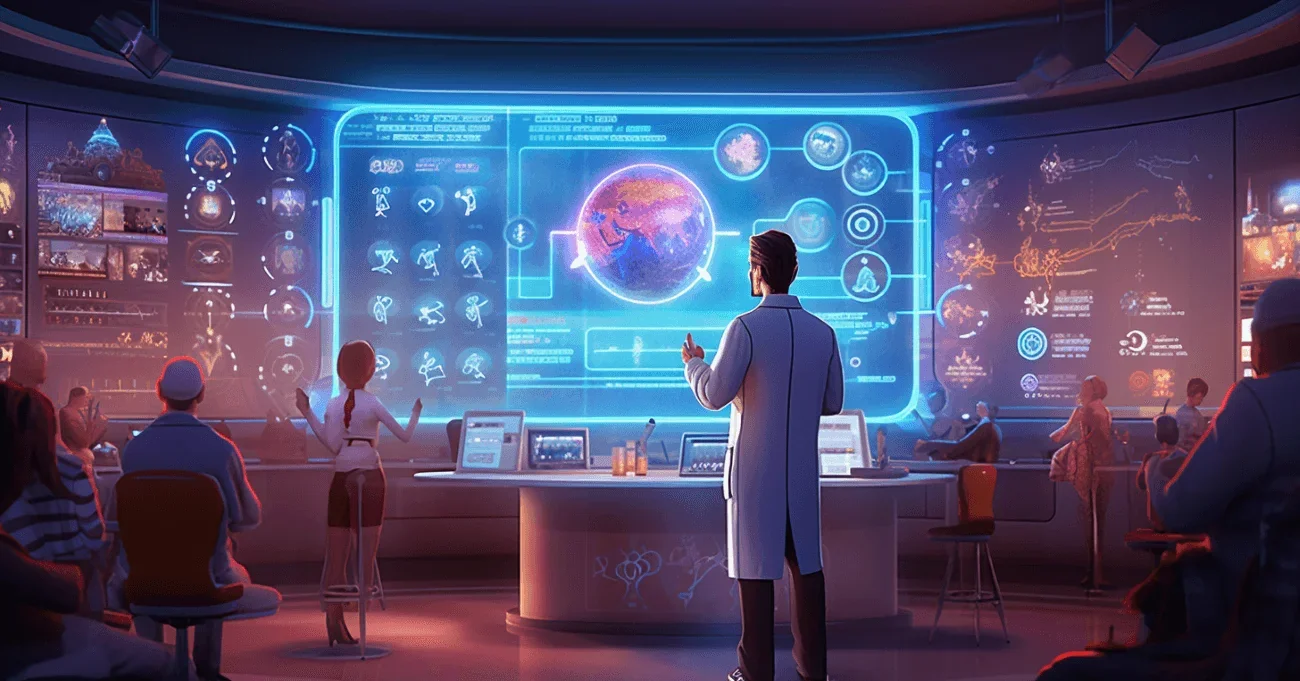Healthcare learning management systems are crucial in training and educating medical professionals, providing a centralized platform for curriculum delivery, assessment, and continuous learning. These systems streamline the onboarding process for healthcare staff, ensuring compliance with industry standards and regulations.
However, successful implementation requires carefully considering user experience, customization options, and integration with existing healthcare workflows.
At Aloa, a software outsourcing company specializing in innovative solutions, we understand the intricate needs of healthcare learning management systems. Our expert team specializes in designing and developing tailored LMS platforms that seamlessly align with the unique training requirements of healthcare institutions.
This blog will delve into the intricate process of building healthcare learning management systems, offering valuable insights into the critical development and customer discovery stages. By the end of this blog, you will gain a comprehensive understanding of the steps involved in crafting a robust and tailored LMS solution for healthcare education.
Let's dive in!
7 Steps in Building Healthcare Learning Management Systems
The integration of healthcare learning management systems has revolutionized medical education. This strategic evolution is meticulously designed to align seamlessly with the dynamic needs of healthcare professionals, ensuring the creation of practical solutions that elevate the training experience. Here is the development process of LMS for the healthcare industry:
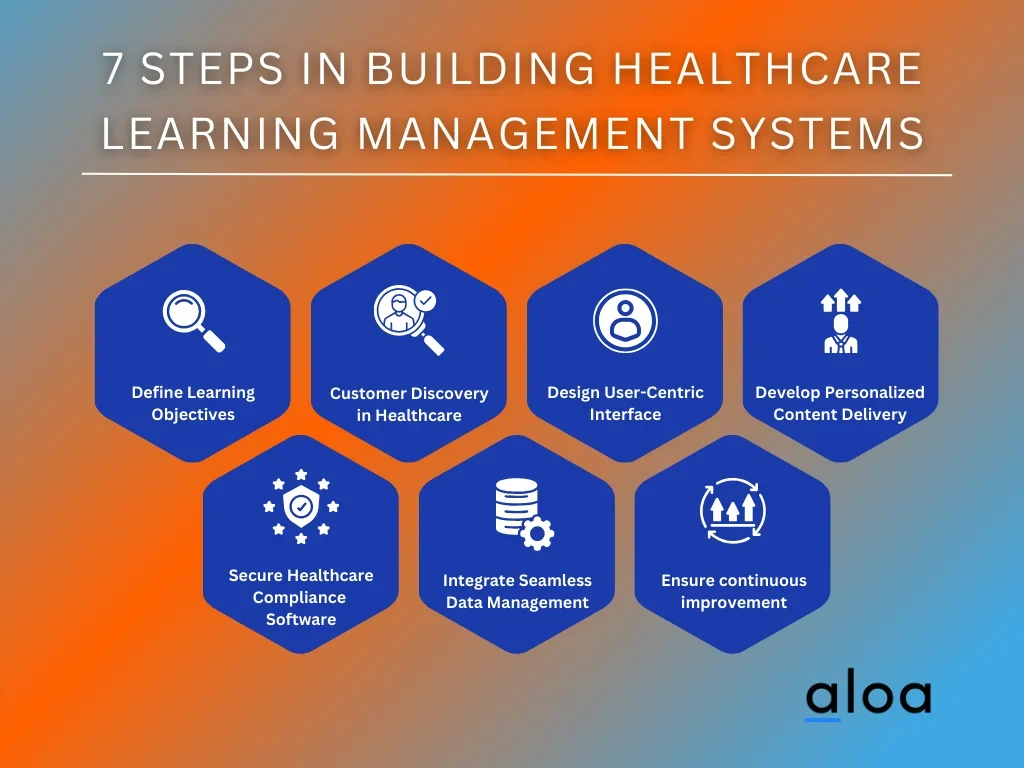
Step 1: Define Learning Objectives
Defining clear and specific learning objectives is paramount in the initial phase of building healthcare learning management systems. This involves collaborating with healthcare stakeholders to identify the system's core competencies and skills to impart to its users. By outlining these objectives, developers can create a roadmap for the content and features that the healthcare learning management systems (LMS) will encompass.
With a focus on the unique needs of healthcare professionals, defining learning objectives serves as the foundation for a targeted and practical educational experience. This step involves understanding the theoretical knowledge required and recognizing the practical skills and competencies healthcare providers need to excel in their roles. Well-designed LMS software helps translate these theoretical and practical needs into structured, trackable learning pathways. Through a comprehensive definition of learning objectives, the subsequent stages of LMS development can align seamlessly with the specific goals and outcomes desired in the healthcare education domain.
By meticulously defining learning objectives at the outset, the healthcare LMS can be tailored to address specific challenges and gaps in medical training. This proactive approach ensures that the subsequent steps in the development process align closely with the overarching goals of enhancing healthcare education, providing a solid foundation for creating a purpose-driven learning management system.
Step 2: Conduct Customer Discovery in a Healthcare Context
Before diving into the development phase, understanding the healthcare industry's unique requirements is essential. This step helps create an HLMS that aligns with healthcare professionals' and organizations' specific needs and challenges.
Critical Actions in Conducting Customer Discovery:
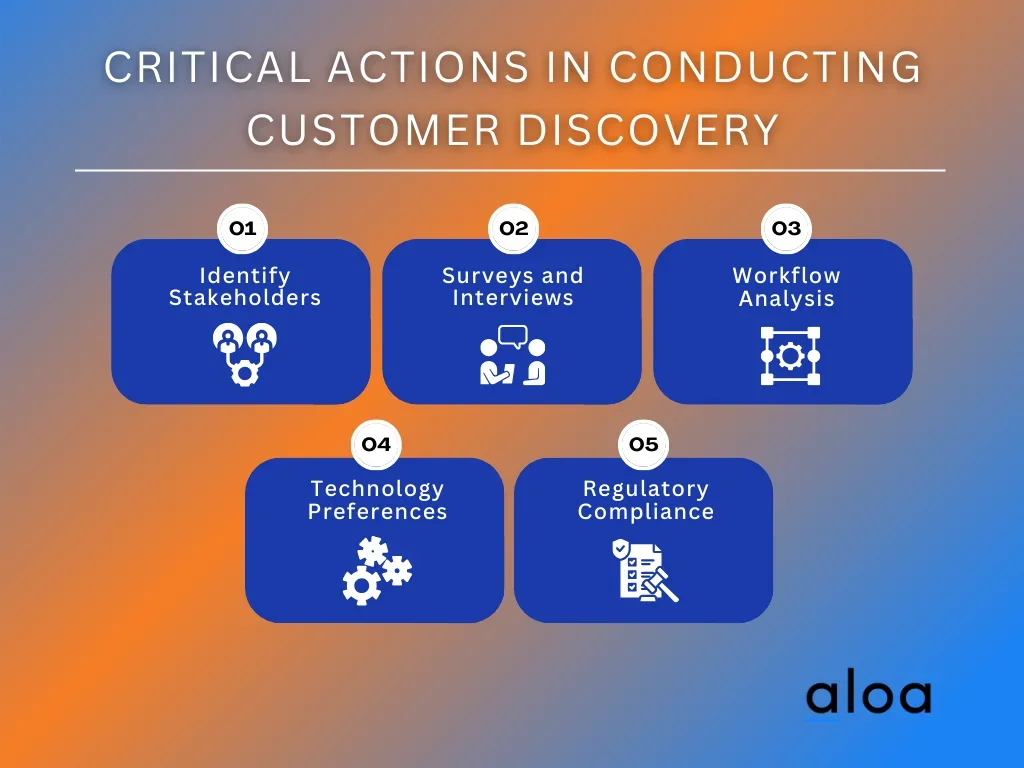
- Identify Stakeholders: Identify key stakeholders within the healthcare ecosystem, including administrators, educators, and healthcare practitioners.
- Surveys and Interviews:Conduct surveys and interviews to gather firsthand insights into the current challenges and preferences related to healthcare training.
- Workflow Analysis: Analyze the workflow of healthcare professionals to identify potential bottlenecks and areas where a learning management system can enhance efficiency.
- Technology Preferences: Explore the technology preferences of healthcare institutions, ensuring compatibility and seamless integration with existing systems.
- Regulatory Compliance: Understand the regulatory landscape in healthcare education to ensure that the HLMS aligns with industry standards and compliance requirements.
By involving stakeholders, understanding workflow nuances, and addressing regulatory considerations, conducting customer discovery sets the foundation for developing an HLMS that meets and exceeds the healthcare community's expectations.
Step 3: Design User-Centric Interface
Creating a healthcare learning management system with an intuitive and user-centric interface is paramount for ensuring a positive user experience. In this step, the focus shifts to designing an interface that facilitates easy navigation, promotes engagement, and aligns with the unique workflow of healthcare professionals.
By incorporating user feedback and industry best practices, developers aim to craft an interface that not only enhances accessibility but also addresses specific challenges faced by learners in the healthcare sector. The design process involves thoughtful consideration of visual elements, such as layout, color schemes, and interactive features, to create a seamless and aesthetically pleasing experience.
Emphasis is placed on optimizing the user interface for various devices, acknowledging the diverse environments in which healthcare professionals may engage with the learning management system. Ultimately, a user-centric design ensures that healthcare learners can efficiently access and absorb educational content, fostering a conducive environment for continuous learning and skill development.
By aligning the design with the specific needs of healthcare professionals, the user-centric interface becomes a crucial element in promoting user engagement and satisfaction. This step enhances the overall usability of the healthcare learning management system. It contributes significantly to the effectiveness of medical education delivery.
Step 4: Develop Customized Content Delivery Systems
Creating an effective Healthcare Learning Management System (HLMS) involves tailoring content delivery systems to meet healthcare professionals' unique learning preferences and requirements. This step focuses on developing flexible and personalized methods for delivering educational content within the healthcare sector.
Healthcare professionals often have diverse learning styles and time constraints. Customized content management systems ensure that educational materials are presented in a manner that aligns with the preferences and schedules of healthcare learners.
Key Actions in Developing Customized Content Delivery Systems:
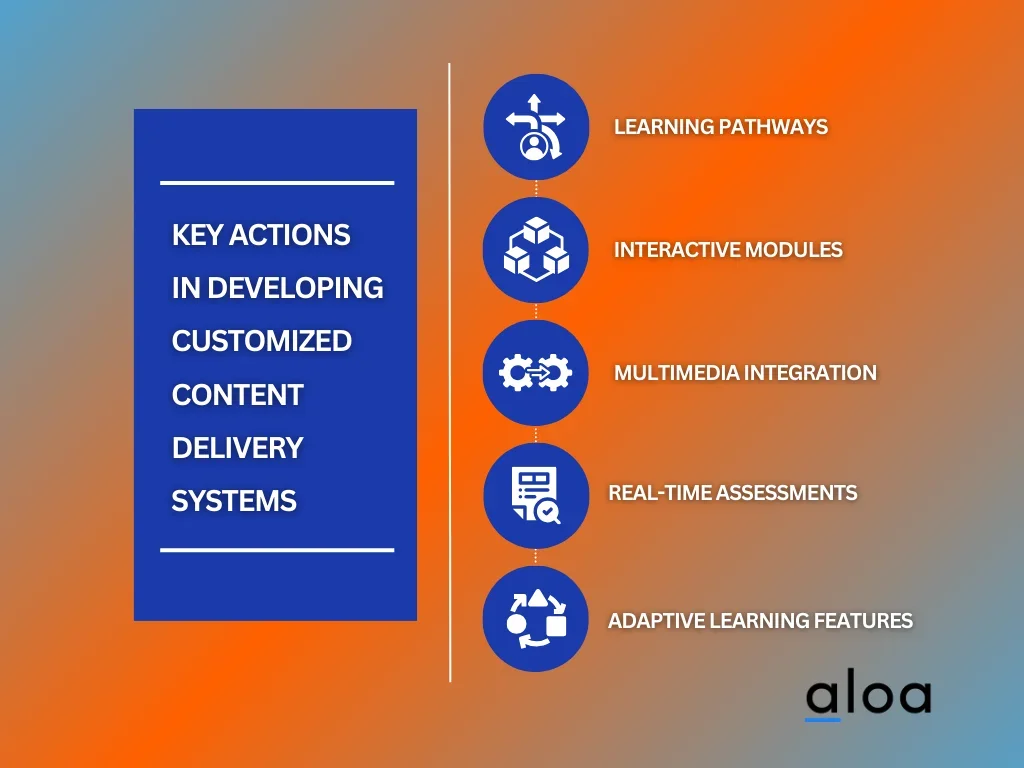
- Learning Pathways: Tailor learning journeys to roles and specializations, ensuring relevant content delivery that meets the specific needs of healthcare employees within the LMS systems.
- Interactive Modules: Elevate engagement by integrating training material like quizzes, simulations, and case studies directly into the content delivery system, fostering hands-on online learning experiences. This approach enhances comprehension and skill development, making it an effective strategy for delivering training courses.
- Multimedia Integration: Support diverse learning programs and styles with integrated videos, animations, and podcasts, enriching the educational experience and accommodating a range of preferences within the healthcare sector. This multimedia approach ensures the effectiveness of training content, catering to varied learning preferences and enhancing overall engagement.
- Real-time Assessments: Implement assessment tools to track learner progress and offer instant feedback, empowering healthcare professionals to monitor their career development with upskilling and reskilling within the LMS software.
- Adaptive Learning Features: Deliver a personalized learning experience by adjusting content delivery based on individual performance and preferences, ensuring an adaptive and effective educational journey.
Developing customized content delivery systems ensures that healthcare learners have access to a flexible and adaptive learning environment. By incorporating interactive elements, multimedia, and adaptive features, the LMS becomes a dynamic platform that caters to healthcare professionals' diverse needs, ultimately enhancing healthcare education's effectiveness.
Step 5: Ensure Compliance with Healthcare Standards and Regulations
Ensuring compliance with healthcare standards and regulations, including meticulous navigation through industry-specific guidelines such as HIPAA, is pivotal in developing robust learning management systems. Developers guarantee that the plan aligns with the highest standards of healthcare education, incorporating features that facilitate seamless compliance training for every medical staff within the healthcare sector.
This step involves incorporating necessary security measures and staying abreast of evolving regulations in compliance management to adapt the learning management system to the dynamic landscape of healthcare compliance. The emphasis on compliance extends beyond data security to encompass content delivery and accreditation processes.
By adhering to established healthcare standards, the learning management system becomes a reliable and trusted platform for medical education. This commitment to compliance safeguards sensitive information and instills confidence in healthcare institutions and professionals, ensuring that the learning environment remains secure and conducive to practical training.
Step 6: Integrate Seamless Data Management
In developing Healthcare Learning Management Systems (HLMS), integrating seamless data management is crucial for ensuring the efficient handling of information critical to healthcare education. This step focuses on creating a robust system that effectively collects, organizes, and secures data within the HLMS.
Critical Actions in Integrating Seamless Data Management:
- Unified Data Storage: Establish a centralized system for educational content, user progress, and assessments, facilitating streamlined data access and management.
- Interoperability with Existing Systems: Ensure compatibility with other healthcare systems, allowing seamless exchange of data and information and avoiding data silos.
- Security Protocols: Implement robust security measures to safeguard sensitive healthcare information, adhering to industry standards and compliance requirements.
- Analytics and Reporting Tools: Integrate analytics and reporting tools to track user progress, assess learning outcomes, and gather insights for continuous improvement.
- User Data Privacy Features: Incorporate features prioritizing user data privacy, earning trust through transparent data management practices, and compliance with relevant regulations.
By seamlessly integrating data management into the HLMS, healthcare professionals can access, analyze, and contribute to educational data efficiently and securely, ultimately enhancing the effectiveness of the learning platform.
Step 7: Implement Continuous Improvement Mechanisms
Implementing continuous improvement mechanisms is crucial in building effective healthcare learning management systems. This involves establishing feedback loops, performance analytics, and regular assessments to identify areas for enhancement. By embracing a culture of ongoing improvement, developers ensure that the LMS evolves to meet the dynamic needs of healthcare education.
Regularly gathering user feedback and analyzing system performance metrics allows for targeted refinements in content delivery, user experience, and overall functionality. This iterative approach enhances the adaptability of the healthcare learning management system. It fosters a responsive environment that swiftly addresses emerging challenges in medical education.
The commitment to continuous improvement ensures that the LMS remains a cutting-edge solution, empowering healthcare professionals with the latest advancements in knowledge and skills.
Features in Building a Healthcare Learning Management Systems
Investing in advanced healthcare learning management systems is a strategic decision for organizations committed to excellence in healthcare education. This commitment is further reinforced as we explore the key features that empower healthcare learning management systems to provide a cutting-edge and personalized educational experience.
Features for Admins
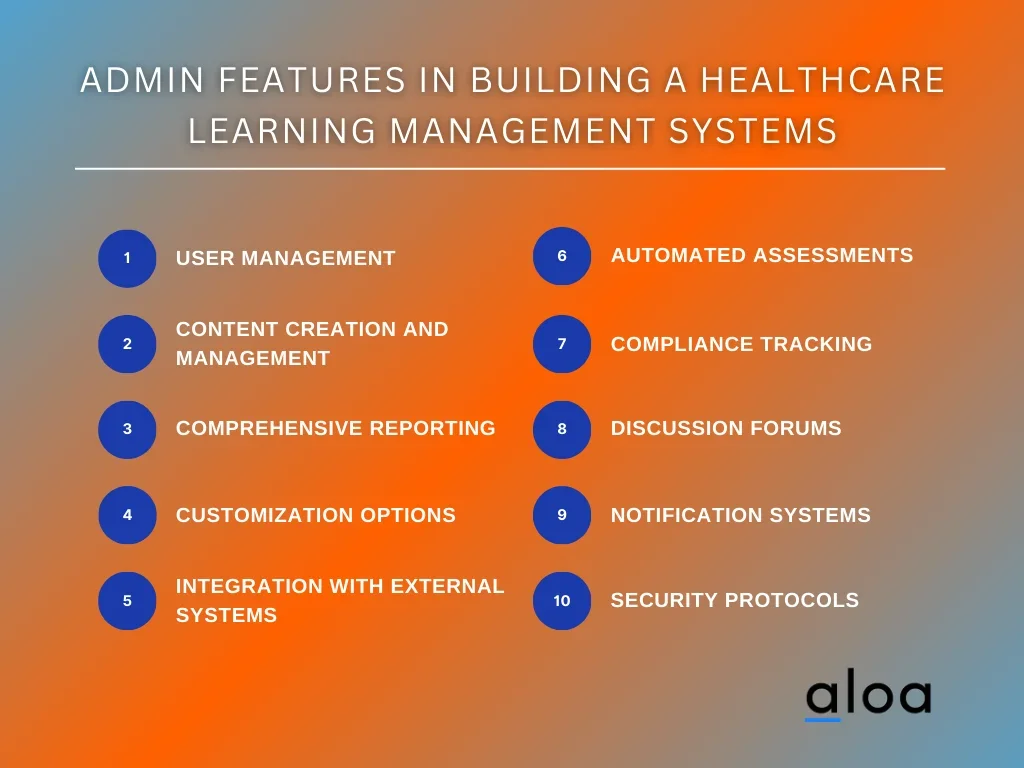
- User Management: Admins can seamlessly integrate performance management into their tasks, efficiently managing and organizing user profiles to ensure easy access to educational resources.
- Content Creation and Management: Admins can leverage the platform to create, edit, and organize diverse healthcare content, tailor learning materials to specific needs, and seamlessly manage the delivery of complete courses.
- Comprehensive Reporting: Robust reporting tools enable admins to track user progress, assess performance, and identify areas for improvement in healthcare education, fostering extensive employee development and enhancing the effectiveness of the training program.
- Customization Options: Admins can personalize the learning experience by configuring settings and adapting the platform to the unique requirements of the healthcare institution.
- Integration with External Systems: Seamless integration with other healthcare systems facilitates data exchange and ensures a cohesive educational ecosystem.
- Automated Assessments: Admins can design and schedule assessments, automating the evaluation process and providing timely feedback to healthcare learners.
- Compliance Tracking: Admins can monitor and ensure compliance with healthcare standards, regulations, and accreditation requirements.
- Discussion Forums: Facilitate collaborative and social learning by managing discussion forums fostering engagement among healthcare professionals.
- Notification Systems: Admins can set up automated notifications to inform users about new content, updates, and important announcements.
- Security Protocols: Implement robust security measures to safeguard sensitive healthcare data and maintain the integrity of the learning management system.
Features for Users

- Intuitive Dashboard: Users benefit from a user-friendly dashboard that provides easy navigation and quick access to relevant healthcare learning materials.
- Personalized Learning Paths: Tailored learning paths guide users through a curriculum customized to their roles, enhancing relevance and engagement.
- Interactive Content: Integrating engaging multimedia content, such as videos, simulations, and interactive modules, not only enriches the learning experience for healthcare professionals but also enhances the overall customer experience.
- Progress Tracking: Users can monitor their individual progress, track completed modules, and identify areas for improvement in real time.
- Mobile Accessibility: By incorporating features for mobile learning that are accessible on various devices, users can seamlessly continue their education anytime, anywhere, enhancing flexibility in healthcare learning.
- Collaborative Tools: Users can participate in discussion forums, collaborate with peers, and share insights to foster community in healthcare education.
- Assessment Feedback: Receive timely feedback on assessments, enabling users to understand their strengths and areas for development.
- Resource Libraries: Access comprehensive libraries of healthcare resources, including articles, journals, and reference materials, to explore enriching course content for in-depth learning.
- Certification Tracking: Users can monitor and track their certifications, ensuring compliance with healthcare standards and professional development requirements.
- User Support and Helpdesk: Access a user-friendly helpdesk and support system for prompt assistance and guidance throughout the healthcare learning journey.
Benefits of Building a Healthcare Learning Management Systems
Building a healthcare learning management system is a strategic investment with transformative implications for healthcare professionals' education and professional development. Here are the benefits of building a robust healthcare learning management system that not only enhances accessibility but also elevates the quality and efficiency of medical education.
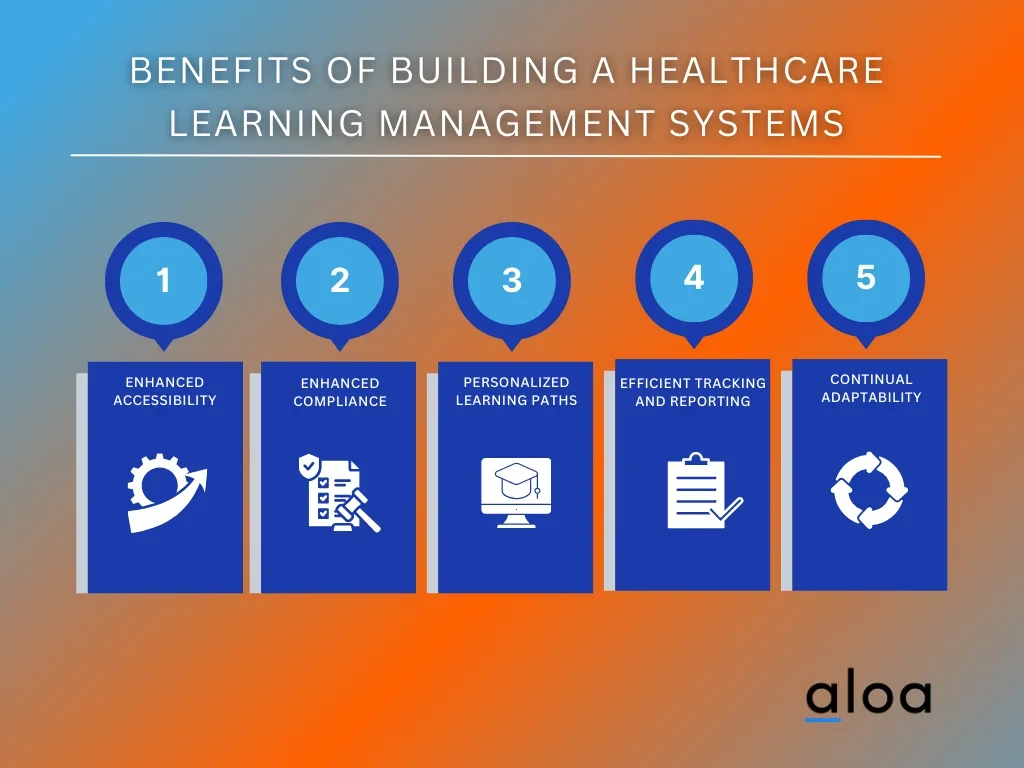
Enhanced Accessibility
Building a healthcare learning management system promotes enhanced accessibility, allowing healthcare professionals to access educational resources anytime, anywhere. This benefit is particularly crucial for busy professionals who need flexible learning schedules, ensuring they can acquire new skills without disrupting their daily responsibilities.
Improved Compliance and Standardization
A healthcare learning management system ensures improved compliance with industry standards and regulations. By centralizing educational content and assessments, the system facilitates standardization in training, ensuring that all healthcare professionals receive consistent and up-to-date information. This enhances the quality of education and helps healthcare organizations meet regulatory requirements.
Personalized Learning Paths
The system enables the creation of personalized learning paths tailored to healthcare professionals' specific needs and roles. This customized approach ensures learners engage with content relevant to their specialties, promoting a more effective and engaging educational experience. It empowers individuals to progress at their own pace, accommodating diverse learning styles and preferences.
Efficient Tracking and Reporting
A healthcare learning management system provides robust tracking and reporting tools for administrators. This allows for efficient monitoring of user progress, assessment results, and overall system utilization. Such insights enable administrators to identify areas for improvement, tailor content to address specific needs and ensure that the learning objectives align with organizational goals.
Continuous Improvement and Adaptability
One of the key benefits lies in the system's capacity for continuous improvement and adaptability. Regular feedback mechanisms and data analytics empower administrators to refine content, enhance user experience, and adapt the approach to the evolving landscape of healthcare education. This iterative process ensures that the learning management system remains cutting-edge, aligning with the dynamic requirements of the healthcare industry.
Key Takeaway
Technology integration in healthcare learning management systems has revolutionized medical education, contributing to the growth of the learning management system market. Hospitals and healthcare institutions rely on robust LMS to maintain high standards of patient care, emphasizing the critical need for professionals to understand how to build and optimize these systems.
With the healthcare landscape evolving rapidly, a comprehensive understanding of the development process, including considerations for clinical education, ensures that educational platforms align with industry standards, regulatory requirements, and the unique needs of medical professionals.
Aloa, a software outsourcing company with a pool of tech talents, is here to transform your vision into reality. Connect with us at [email protected] for innovative and tailored solutions to elevate your healthcare education platform.

